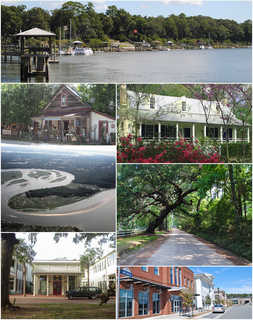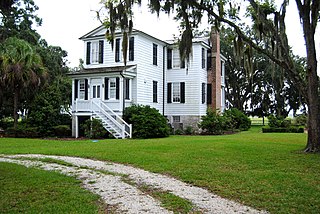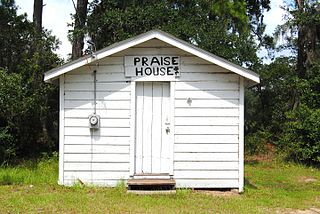
Beaufort is a city in and the county seat of Beaufort County, South Carolina, United States. Chartered in 1711, it is the second-oldest city in South Carolina, behind Charleston. The city's population was 12,361 in the 2010 census. It is a primary city within the Hilton Head Island-Bluffton-Beaufort, SC Metropolitan Statistical Area.

Bluffton is a town in Beaufort County, South Carolina, United States. It is primarily located around U.S. Route 278, between Hilton Head Island and Interstate 95. The Lowcountry town's original one square mile area, now known as Old Town, is situated on a bluff along the May River. The population as of the 2020 census was 27,716, an increase of over 120% since 2010, making it one of the fastest growing municipalities in South Carolina with a population over 2,500. Bluffton is the fifth largest municipality in South Carolina by land area. The town is a primary city within the Hilton Head Island-Bluffton-Beaufort, SC Metropolitan Statistical Area.

Port Royal is a town on Port Royal Island in Beaufort County, South Carolina, United States. Largely because of annexation of surrounding areas, the population of Port Royal rose from 3,950 in 2000 to 10,678 in 2010, a 170% increase. As defined by the U.S. Census Bureau, Port Royal is included within the Hilton Head Island-Bluffton-Beaufort, SC Metropolitan Statistical Area. Port Royal is home to Marine Corps Recruit Depot Parris Island and Naval Hospital Beaufort.

Marine Corps Recruit Depot Parris Island is an 8,095-acre (32.76 km2) military installation located within Port Royal, South Carolina, approximately 5 miles (8.0 km) south of Beaufort, the community that is typically associated with the installation. MCRD Parris Island is used for United States Marine Corps Recruit Training of enlisted United States Marines. Recruits living east of the Mississippi River report there to receive initial training. Recruits living west of the Mississippi River receive training at Marine Corps Recruit Depot San Diego, California, but may train at MCRD Parris Island by special request.

Beaufort Historic District is a historic district in Beaufort, South Carolina. It was listed on the National Register of Historic Places in 1969, and was declared a National Historic Landmark in 1973.

The Palmer-Marsh House is a historic house museum and National Historic Landmark on Main Street south of Carteret Street in Bath, North Carolina. Built in 1744, it is one of the oldest residences in North Carolina, and is a well-preserved example of a large colonial town house with a commercial space built in. It was declared a National Historic Landmark in 1970. It is now a North Carolina state historic site, and is open for tours.
The Charlesfort-Santa Elena Site is an important early colonial archaeological site on Parris Island, South Carolina. It contains the archaeological remains of a French settlement called Charlesfort, settled in 1562 and abandoned the following year, and the later 16th-century Spanish settlement known as Santa Elena. The Spanish remains include a fort built directly on top of the abandoned Charlesfort remains. This fort and other nearby structures have been called, at various times, Fort San Marcos, Fort San Felipe, and have the designated archaeological site identifiers 38BU51 and 38BU162. Because of their remarkable state of preservation, and their importance in understanding early French and Spanish colonial practices, the site was designated a National Historic Landmark in 2001. The site is accessible through the United States Marine Corps Recruit Depot in Port Royal, South Carolina.

Tabby Manse, also known as Thomas Fuller House, is a building in Beaufort, South Carolina.

Seabrook is an unincorporated community and census-designated place (CDP) located in Beaufort County, South Carolina, United States. It was first listed as a CDP in the 2020 census with a population of 1,255.

The Corner Store and Office, also known as the Frogmore Emporium, Macdonald, Wilkins, and Company Store and Mark D. Batchelder Office, is a historic general store, residence and, eventually, office building located on Saint Helena Island near Frogmore, Beaufort County, South Carolina. Primarily built as a house, it was built about 1877, and is a two-story, wood-frame building with a gable roof. It features a two-story wraparound porch. The adjacent one-story house was built about 1905. The store sold provisions to the islanders, most of whom were African American, and became one of the major centers of commercial and social activity on St. Helena. The home and businesses in the building were owned by Cameron Thomas and his relatives for most of the 20th century. The family lived in the back and upstairs portion of the house, while the front included a general store and liquor store, with the small house added on used as a residence for relatives. The store also had the only gas pump on the island for many years.
The Oaks, also known as the Cooler House, is a historic plantation house located on Saint Helena Island near Frogmore, Beaufort County, South Carolina. It was built about 1855, and is a two-story, vernacular frame I-House. Edward L. Pierce chose The Oaks as his headquarters during the military occupation of St. Helena during the American Civil War. The Oaks was the center for military and agricultural activities on the island. On June 18, 1862, Ellen Murray, who had ten days earlier arrived from Pennsylvania, opened the Penn School for Freedmen in a back room of the house. The house also served as a hotel for military personnel from Port Royal, superintendents, and teachers.

Tombee Plantation is a historic plantation house located on Saint Helena Island near Frogmore, Beaufort County, South Carolina. It was built about 1790–1800, and is two-story, T-shaped frame dwelling. It is sheathed in clapboard and has a gable roof. It features a single-story front portico with four square columns and a two-story balustraded rear porch with six square columns on each floor. Along with Seaside Plantation, it is one of the few surviving antebellum plantation houses remaining on St. Helena Island. The Tombee Plantation property was divided into tracts during the days of the "Port Royal Experiment" in 1862. It remained in the hands of descendants of freed slaves until 1971.
Seaside Plantation, also known as the Edgar Fripp Plantation, is a historic plantation house located on Saint Helena Island near Beaufort, Beaufort County, South Carolina. It was built about 1795 to 1810, and is a two-story, frame dwelling in a transitional Georgian / Federal style. It features one-story hip roofed portico. Seaside was one of the plantations participating in the Port Royal Experiment and had as its labor superintendent Charles Pickard Ware (1840–1921). Charlotte Forten Grimké (1837-1914) also resided at Seaside Plantation. Along with Tombee Plantation, Seaside is one of only a few remaining antebellum plantation houses on St. Helena. Also on the property are the contributing original, brick-lined well, a clapboard shed, a large barn with clapboard siding and tin roof, and a round concrete and oyster shell silo.

Eddings Point Community Praise House is a historic church located on Saint Helena Island near Frogmore, Beaufort County, South Carolina. It was built about 1900, and is a narrow, one-story gable roofed building of frame construction with the entrance in the gable end. It is significant as one of four known extant African-American praise houses on St. Helena Island, and was a central place in the religious and social life of the black islanders.

Mary Jenkins Community Praise House is a historic church located on Saint Helena Island near Frogmore, Beaufort County, South Carolina. It was built about 1900, and is a narrow, one-story gable roofed building of frame construction with the entrance in the gable end. It is significant as one of four known extant African-American praise houses on St. Helena Island. The building remains in use.
Orange Grove Plantation is a historic plantation house and national historic district located on Saint Helena Island near Frogmore, Beaufort County, South Carolina. The district encompasses one contributing building and two contributing sites, and reflects the early-20th century influx of Northerners onto St. Helena Island. The plantation was first recorded in 1753 when Peter Perry purchased 473 acres. Perry owned 46 chattel slaves. The plantation house, built about 1800, was in poor condition when Henry L. Bowles (1866-1932), a U.S. Representative from Massachusetts, bought the property in 1928. He demolished it and built the present house in the same year. The property also includes the tabby ruin of the kitchen, built about 1800, and a tabby-walled cemetery containing three early-19th century graves of the Fripp and Perry families.
Pine Island Plantation Complex is a historic hunting plantation complex and national historic district located on Pine Island near Frogmore, Beaufort County, South Carolina. The district encompasses six contributing buildings and one contributing sites, and is an early-20th century hunting plantation. The main house at Pine Island was built about 1904, and is a two-story frame structure built on an existing tabby foundation. The front façade features a full-width two-story porch. Also on the property are the contributing cottage, a toolshed/doghouse, a barn, a pumphouse, an automobile garage, and causeway.

McLeod Farmstead, also known as Rest Park Tract and Seabrook Farms, is a historic farmstead and national historic district located at Seabrook, Beaufort County, South Carolina. The district encompasses 12 contributing building and 2 contributing structures, and is representative of the truck farming economy that spread through the region between 1884 and 1946. The contributing farm buildings include the Keyserling gin and McLeod Barn. Two of the buildings served commercial purposes: The McLeod general store and the Keyserling general store. There are also three residential structures: the McLeod House (1905), a two-room shack which likely housed farm workers, and the residence and the office of the farm supervisor.

Union Church of Port Royal, also known as Port Royal White Union Church, 11th Street Tabernacle, and Free Church of Port Royal, is a historic church located at Port Royal, Beaufort County, South Carolina. It was completed in 1878, and consists of a one-story, wood frame, brick-piered building with a central entry and portico. It has a cupola containing the church's belfry. It was built with donated lumber by local citizens in 1877–1878 to provide the Port Royal community its only white house of worship at that time.

The Port Royal School is a historic South Carolina school building. It is located at 1214 Paris Avenue in the town of Port Royal. Its original main block is a two-story Colonial Revival structure designed by Wilson and Sompayrac and built in 1911. In 1954 a single-story brick Modern addition was added to the north of this building; it was designed by William Harleston of Halsey & Cummings. A second addition was made in 2002, further extending the 1954 building to the north. The building is believed to be the second-oldest active elementary school building in the state. It also contributed to the area's checkered history of the provision of so-called "separate but equal" educational facilities for whites and African Americans: the 1954 addition occurred at a time when the last elementary school for African Americans in Port Royal was closed, requiring the transportation of those students to Beaufort. The Port Royal School remained whites-only until 1964.



















